Choosing a smartphone is often considered an arduous work, as you wouldn’t dare to take the wrong call by buying a sub-par device. Apple and Samsung are two of the biggest names in the industry, and it’s obviously perplexing to pick one from their roster of smartphones.
More importantly, it doesn’t just depend on what the phone has to offer, but also on a variety of other factors that contribute to the experience of the user. To make my long story short, this article will guide you on what to decide as your upcoming device: an iPhone or a Samsung Galaxy.
Of course, we’ll spread out all the aspects of selecting a phone from either brands, including their software, apps-support, ecosystems, resale values, above all the general characteristics. Stay tuned until the end to find out more.
Portfolio of Smartphones
Apple has an exquisitely designed lineup of iPhones, which is a child’s play to keep track of. The best part is that it even sells some old yet popular models, which obviously helps people save money. Currently, Apple sells the following devices officially :-
- iPhone 13 Pro
- iPhone 13 Pro Max
- iPhone 13 Mini
- iPhone 13
- iPhone SE
- iPhone 12
- iPhone 11
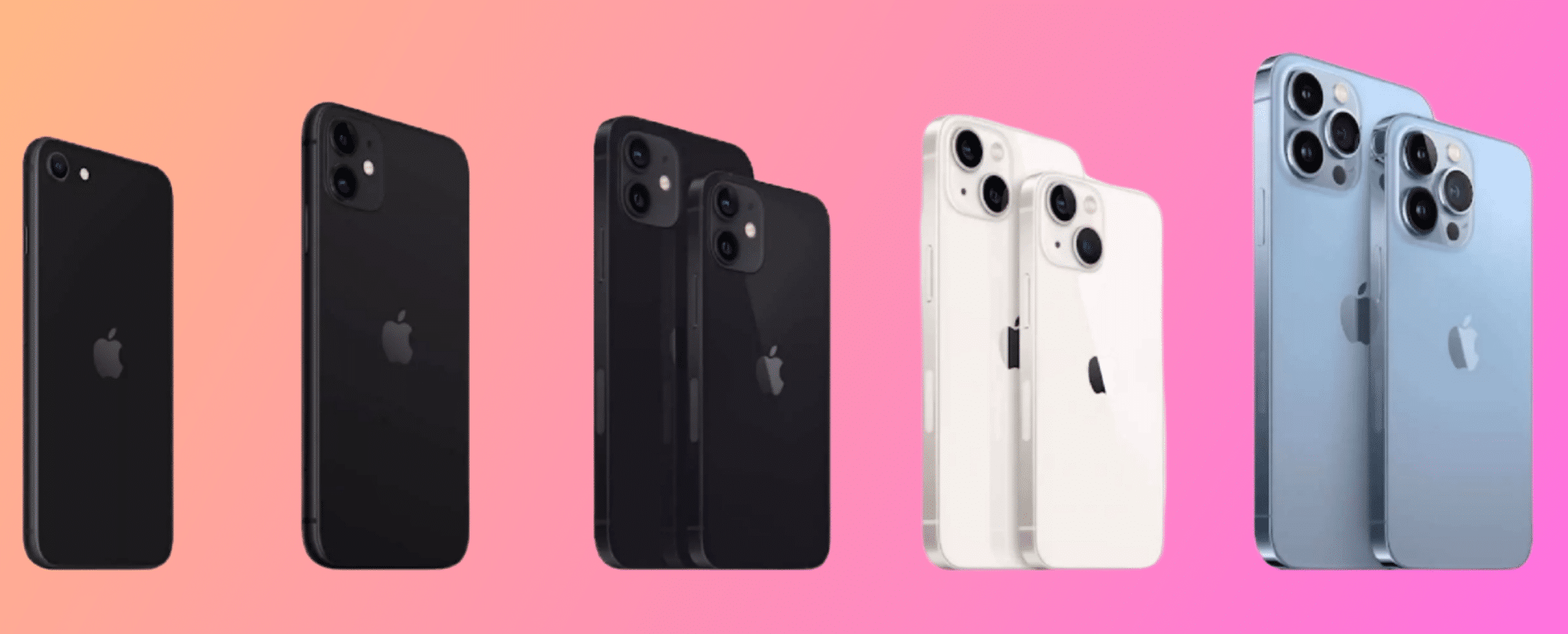
Samsung, on the other hand, has a spaghetti of smartphones to offer. Albeit having a well-defined naming scheme, it still is no way near to Apple’s. Moreover, many series of smartphones aren’t available in all regions. Here’s what Samsung sells in the market currently :-
- Galaxy S series (Flagships): Galaxy S22, Galaxy S22+, and Galaxy S22 Ultra.
- Galaxy Z series (Folding phones): Galaxy Z Flip 3 and Galaxy Z Fold 3.
- Galaxy FE series (Budget flagships): Galaxy S21 FE.
- Galaxy A series (Premium mid-range phones): Galaxy A33, Galaxy A53, Galaxy A73, etc.
- Galaxy M and F series (Budget/mid-range phones; region specific): Galaxy M33, Galaxy M53, Galaxy F13, Galaxy F23, etc.
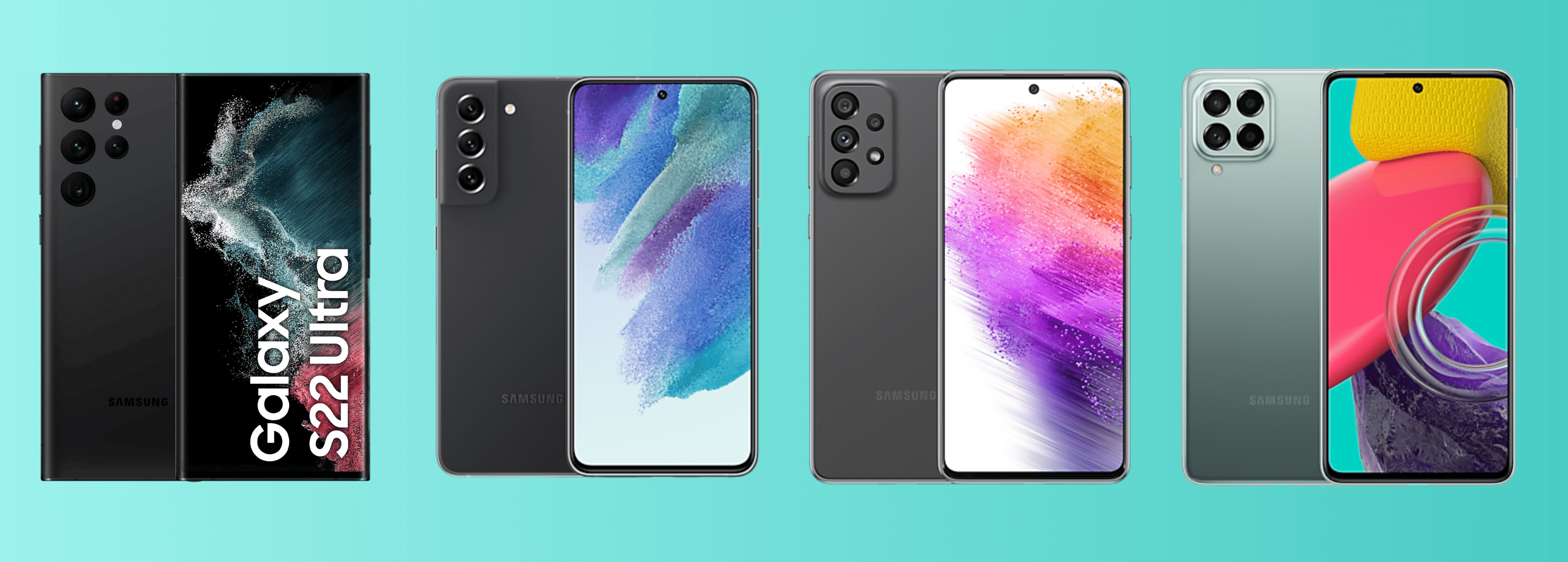
Mind you, we couldn’t even jot down a third of Samsung’s offerings here, which goes to show the vastness of its lineup. Indirectly, it provides more choices for the end consumer. That said, we’ll be comparing the parallel models.
Processor/SoC
The latest processor in Apple’s lineup is the A15 Bionic, whereas it’s the Exynos 2200 (in some countries), or the Qualcomm Snapdragon 8 Gen 1 in Samsung’s flagship lineup. The A15 Bionic is built on a 5 nm platform, and houses 6 cores. Exynos 2200 and Snapdragon 8 Gen 1 are both built on a 4 nm platform, and house 8 cores.
The numbers might tilt you away from Apple’s territory, but wait until you see the actual test results. Shout out to the team at Versus, who tested out the processors in a very detailed manner and posted a video about the same. We’ll be referring to their data and findings in this section.
Let’s start with the benchmarking apps first. The Geekbench result of the three chipsets goes to show how much capable A15 Bionic really is. It is almost thrice as fast as the Exynos 2200 in terms of single-core scores, and nearly 50% faster in terms of multi-core scores. Of course, A15 Bionic is ahead of Qualcomm Snapdragon 8 Gen 1 as well, but the gap isn’t that wide.
The results are similar in the case of Geekbench ML, which tells about the processor’s machine learning and AI capabilities. AnTuTu benchmark isn’t tuned the same as for android, which explains the low scores of Bionic A15. 3D Mark Wildlife Extreme benchmark, which tests the GPU and efficiency, also shows similar trends.

If we elaborate on professional scenarios, like photo editing, exporting, video rendering, etc., the results are nearly the opposite. In the event of batch photo editing, Exynos 2200 knocks it out of the park and finishes the task nearly thrice as fast. Snapdragon, too, finishes it quite faster than A15 Bionic. Exporting pictures is faster on the Snapdragon 8 Gen 1 by quite a massive margin, although the Exynos 2200 finishes a tad bit quicker than the A15 Bionic. The tables turn in the case of video rendering, which is won by the A15 Bionic, whereas Exynos 2200 fails midway. Another point is that most games run better on iPhone, mainly because of optimization. Samsung phones, in general, heat up and eventually throttle while gaming.
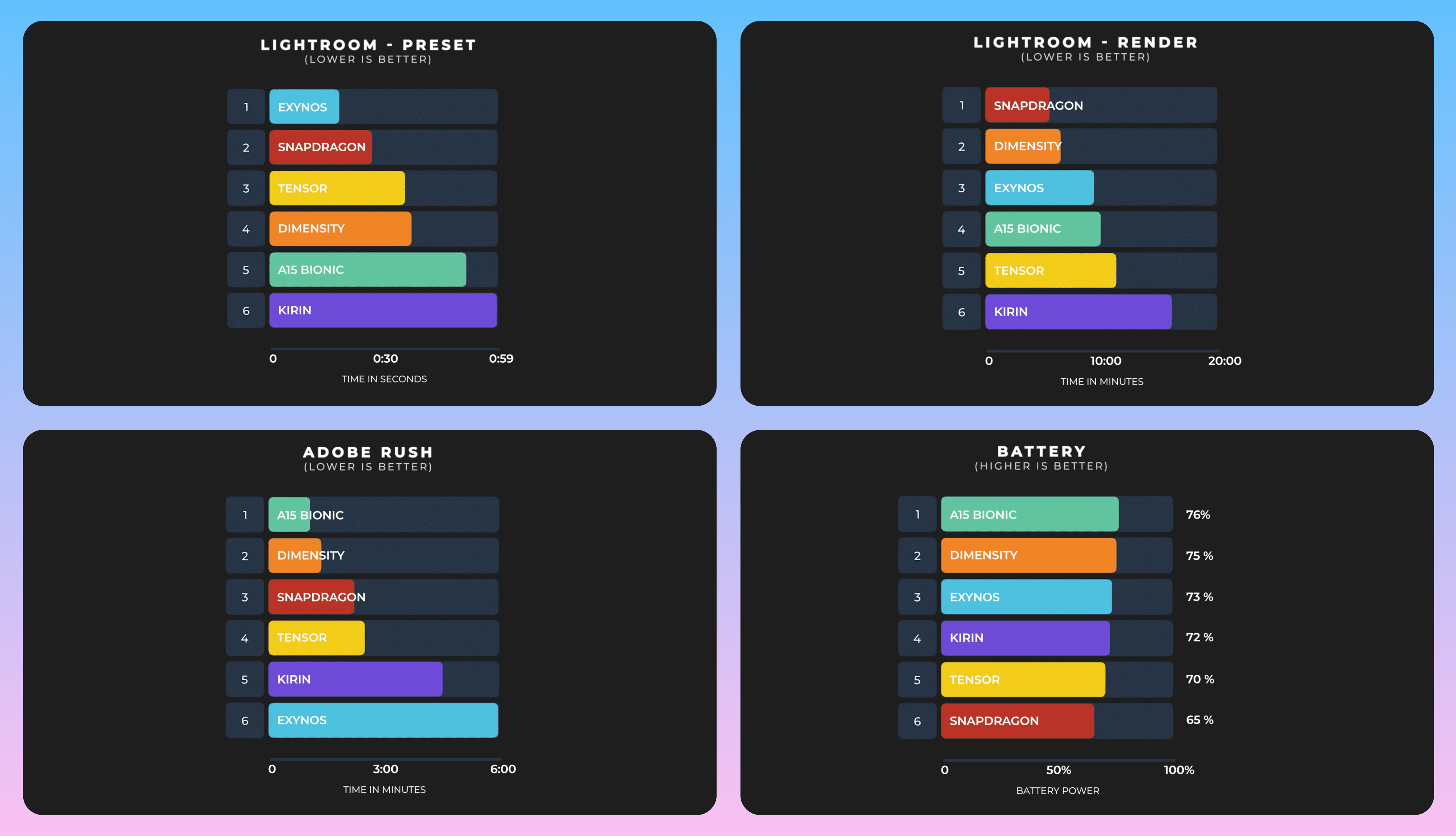
To be really frank, benchmarks are inconsequential in real life scenarios, and any of these SoCs can handle day-to-day tasks with ease. For example, app opening times are neck to neck in most cases. Despite beating the S22 Ultra in RAM management with barely half the capacity, iOS really doesn’t let you take advantage of it.
Almost every background task seizes the second you exit the app. Nevertheless, all these processors heat to a certain extent while benchmarking, but, in real life scenarios, the A15 Bionic generally stays cooler in comparison. These tests depend heavily on the testing conditions, and typically vary accordingly. Thus, these scores shouldn’t be considered as the concluding factor.
Display
If we compare the displays leading the flagships from either brands, we’ll come to know how superior Samsung is. Usually, Samsung’s displays are hands down the better of the two, and sometimes even by a landslide. While the iPhone 13 Pro Max sports a 6.7” Super Retina XDR OLED display with a 120Hz refresh rate and 1200 nits of peak brightness, the Samsung Galaxy S22 Ultra boasts a 6.8” Dynamic AMOLED 2X display with a 120Hz refresh rate and 1750 nits of peak brightness.
More importantly, the Galaxy S22 Ultra houses a curved display with nearly non-existent bezels, which just obliterates the iPhone’s flat display in terms of looks (although some people prefer the latter). Of course, you get to enjoy the iconic iPhone notch, but it’s far from looking better in front of the Galaxy S22 Ultra. The Galaxy S22 Ultra’s display has a maximum resolution of 1440 × 3088 pixels (~500 PPI density) and close to 90.2% screen-to-body ratio, whereas the iPhone 13 Pro Max sits at 1284 × 2778 pixels (~458 PPI density) and close to 87.4% screen-to-body ratio. This difference, however, is barely noticeable in real life.
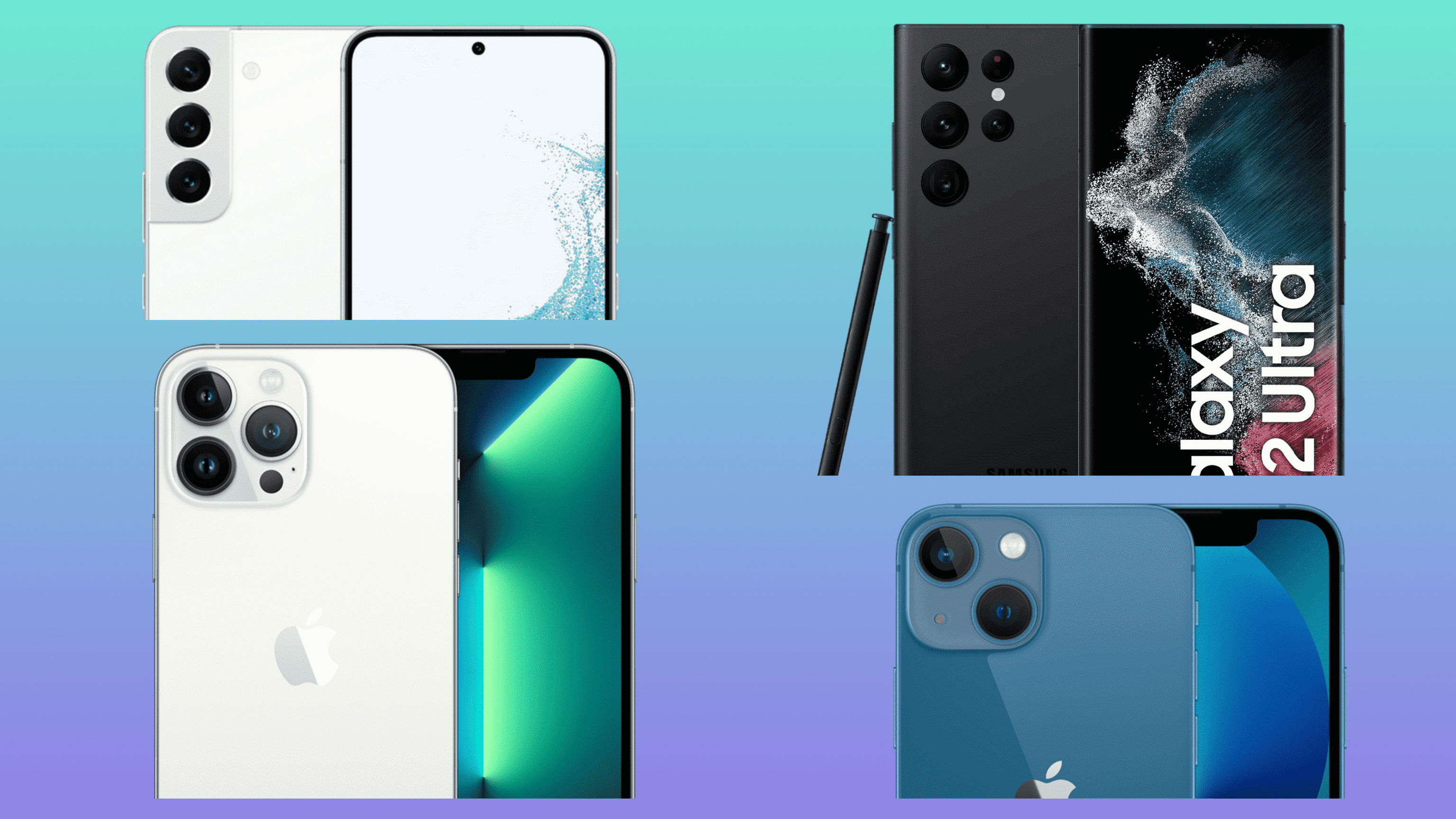
Samsung surely misses out on the Dolby Vision certification which the iPhone has, but, the use case of this advantage is very isolated. Both phones do come with HDR10 certification, and feature LTPO technology, which dynamically adjusts the screen’s refresh rate.
Samsung has a better implemented LTPO technology and also provides the option to tweak the colors of the display, whereas the HDR performance on the iPhone is a lot superior. The Galaxy S22 Ultra has a lower JNCD (just noticeable color difference) than the iPhone 13 Pro Max (0.4 v/s 0.5), which goes to show that the former is a tiny bit more color accurate.
Samsung’s S22 lineup is protected by Gorilla Glass Victus+ on the front, whereas Ceramic Shield protects the front of the iPhones. There’s no point in comparing them, as someone popular on the internet once said, “glass is glass, and glass breaks.”
Samsung hasn’t reserved the deluxe features for its top dogs, as even the base-line Galaxy S22 and S22+ have a 120Hz refresh rate, 1750 nits brightness (only on the Galaxy S22+), and Gorilla Glass Victus+. In contrast, the base-line iPhone 13 and 13 Mini have a higher resolution, PPI density, and peak brightness levels, but they miss out on fast refresh rate panels.
Camera
To get the best taste of either competitors’ camera standards, we’ll be comparing the Galaxy S22 Ultra against the iPhone 13 Pro/Pro Max once more. No brownie points for guessing that the 108 MP (f/1.8; OIS) + 10 MP (f/2.4; 3X telephoto) + 10 MP (f/4.9; 10X telephoto) + 12 MP (f/2.2; ultra-wide) setup on the Galaxy S22 Ultra isn’t necessarily better than the iPhone 13 Pro/Max’s 12 MP (f/1.5; OIS) + 12 MP (f/2.4; 3X telephoto) + 12 MP (f/1.8; ultra-wide) setup.
The Galaxy S22 Ultra also boasts a 40 MP (f/2.2) selfie camera and an additional laser-autofocus system on the rear. In contrast, the iPhone 13 Pro/Pro Max houses a 12 MP (f/2.2) selfie camera along with a LiDAR scanner on the rear end.
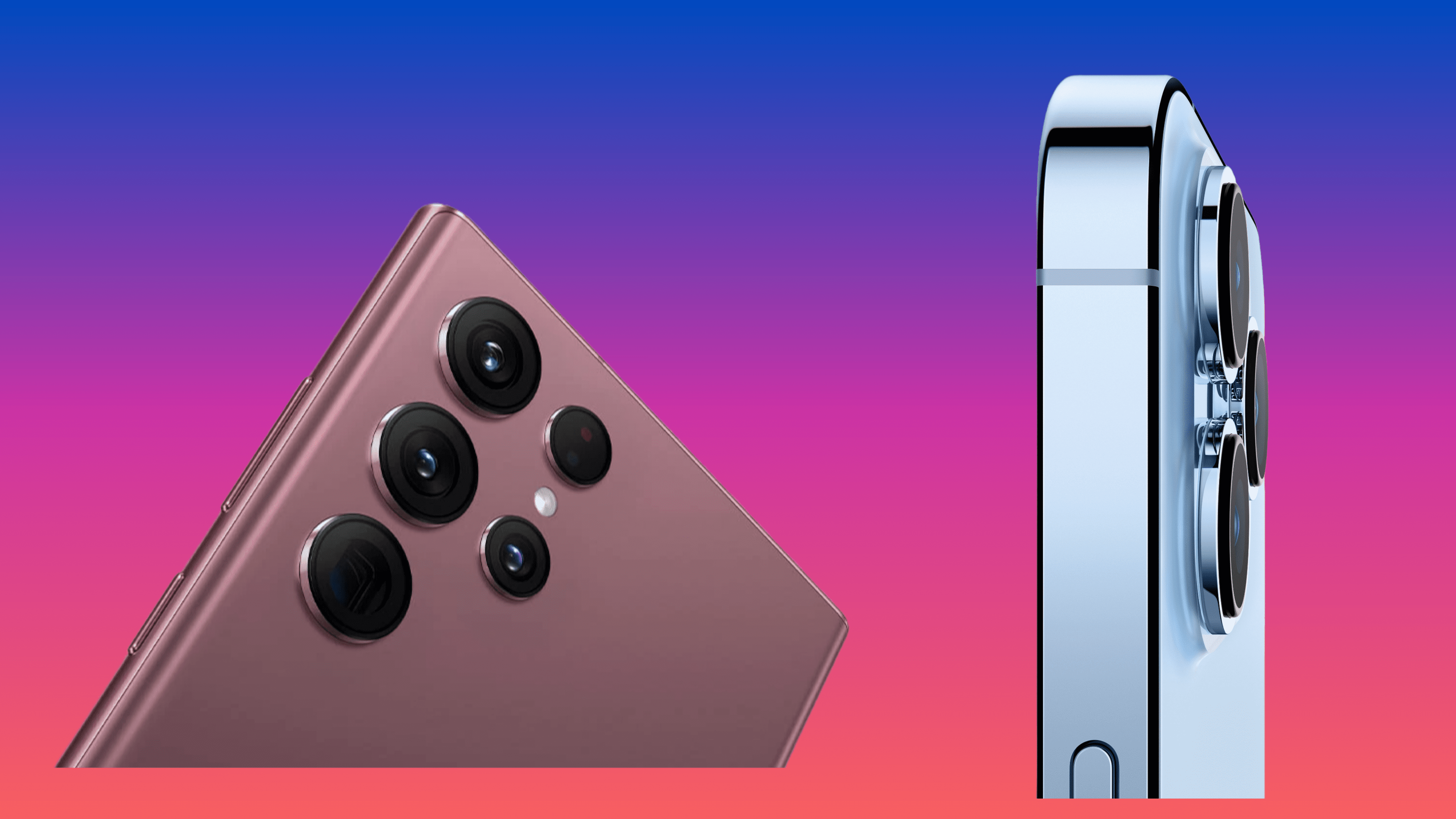
To start with the day-time shots, both the Galaxy S22 Ultra and the iPhone 13 Pro perform unquestionably well. Samsung’s processing opts for a slightly aggressive but quite eye-pleasing colors (for example, the greens and skies look more colorful than in real life). You can achieve a similar output from the iPhone using “Photographic Styles,” but the default processing is geared towards natural-looking shots.
iPhone 13 Pro consistently mishandles the HDR performance in challenging scenarios, like shooting against harsh light, where it underexposes the shadows and blows out the brighter regions. The 108 MP sensor isn’t just for show, as it does help in getting sharper and more detailed shots. However, the large sensor does result in a tiny bit of shutter lag, so, pictures of fast-moving objects might have some amount of motion blur.
Samsung is the king of zooming capabilities, as it can zoom a lot further despite looking superior to the iPhone in every magnification level. You can even click elegant looking pictures of the moon at night. However, the switching of the lenses is a lot smoother on the iPhone than the Galaxy. The iPhone 13 Pro probably has the best-regarded ultra-wide camera, simply because of the color science consistency between other lenses.
The shots, too, are just as good and suffer the same issues as the main sensor. Galaxy S22 Ultra’s ultra-wide camera isn’t exactly better, but it does process photos and maintains the sharpness well. Both phones can use their ultra-wide sensors to capture macro shots. While the Galaxy pumps out a more pleasing picture, the iPhone can focus a lot closer to the subject.
Nighttime shots are arguably better on the Samsung, thanks to the fantastic color processing and large sensor size. The photos are brighter, more detailed, and vibrant on the S22 Ultra, whereas they aren’t as bright on the iPhone. S22 Ultra’s pictures do look unnecessarily bright at times, so there’s nothing wrong in preferring the iPhone in this case. Low-light ultra-wide and telephoto shots are a shade brighter and sharper on the Galaxy.
Speaking of Galaxy, you can do astrophotography on both phones. Talking of portrait shots, Samsung’s advertised “AI Depth Mapping” feature does manage to cut out subjects brilliantly. However, the iPhone’s shots look more aesthetically pleasing, thanks to its detail retention on the main subject and adequate exposure. Low light focusing is also better on the iPhone, mainly because of the LiDAR sensor.
iPhones are the crowned kings of videography, and it’s no different here. The heavenly combination of stabilization, exposure management and HDR performance grant the iPhone to shoot industry-leading footage. Samsung is ever so slightly behind in terms of details and HDR performance, which is ironical, but, it does also miss out on smooth exposure shifts and stable footage, when compared to the iPhone.
The iPhone also excels in low-light videography, however, the S22 Ultra edges out on zooming capabilities. Audio reception is more natural on the iPhone, and is better than the S22 Ultra overall. Selfies are more of a personal preference, but, thanks to the 40 MP sensor, the S22 Ultra clicks sharper selfies. However, iPhone’s way of brightening up your face results in sublime looking selfies. For the same set of reasons, selfie-videography is better on the iPhone.
Both the iPhone 13 series and the Galaxy S22 series have certain unshared features, and some of them worth mentioning are: –
iPhone 13 series
- Photographic Styles – Real-time preset filters that get applied on the pictures directly.
- Cinematic Mode – Professional level portrait mode videography.
- Support for shooting in Dolby Vision HDR – Cinema grade shooting standards.
- LiDAR sensor – For 3D Depth mapping and focusing.
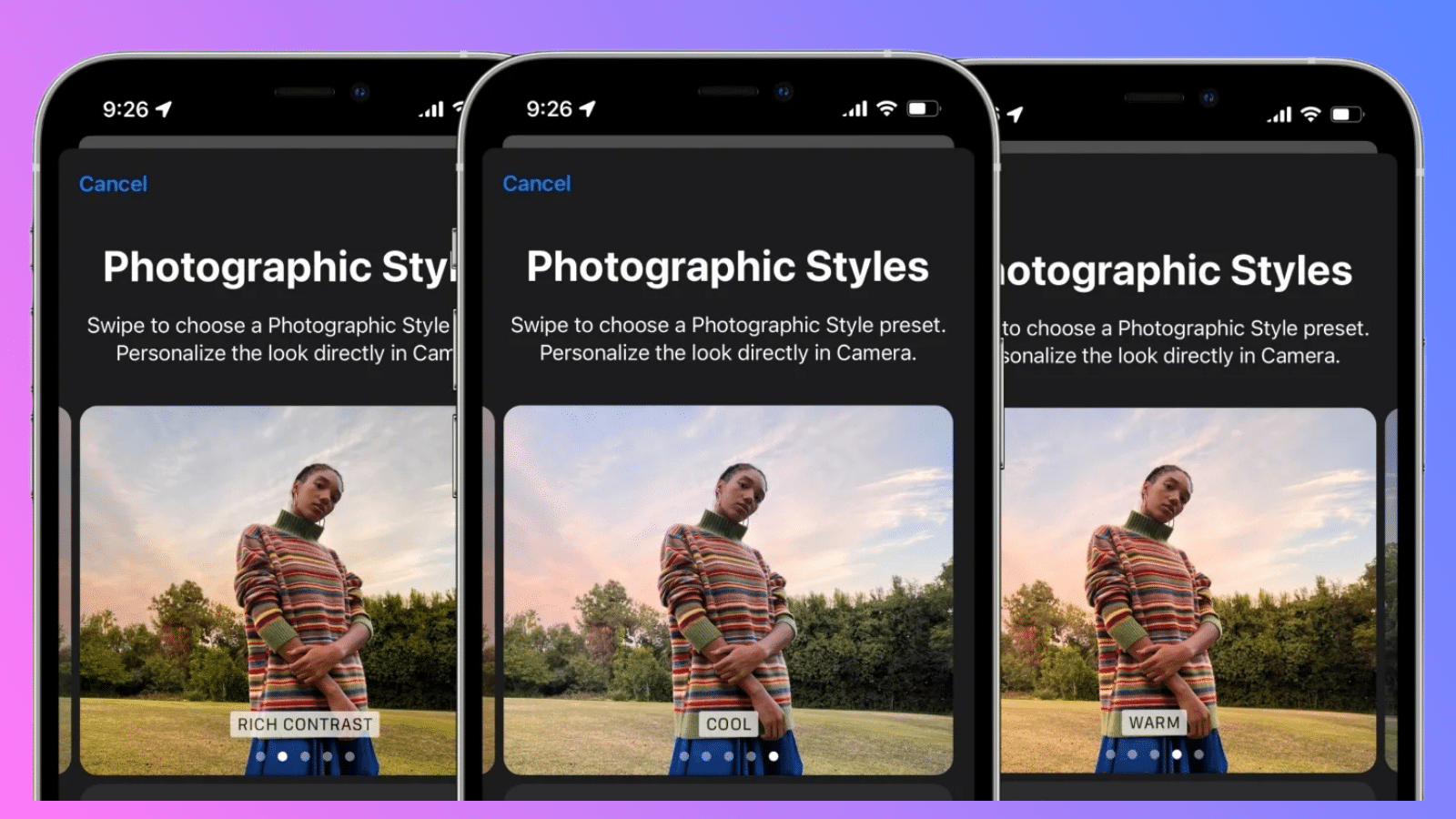
Samsung Galaxy S22 Series
- Director’s View – For viewing footage from all the sensors at the same time.
- 100X Space Zoom (only on the S22 Ultra)
- Pro Mode – Grants granular control over every camera setting.
- Expert RAW application – Allows advanced imaging for Galaxy phones.
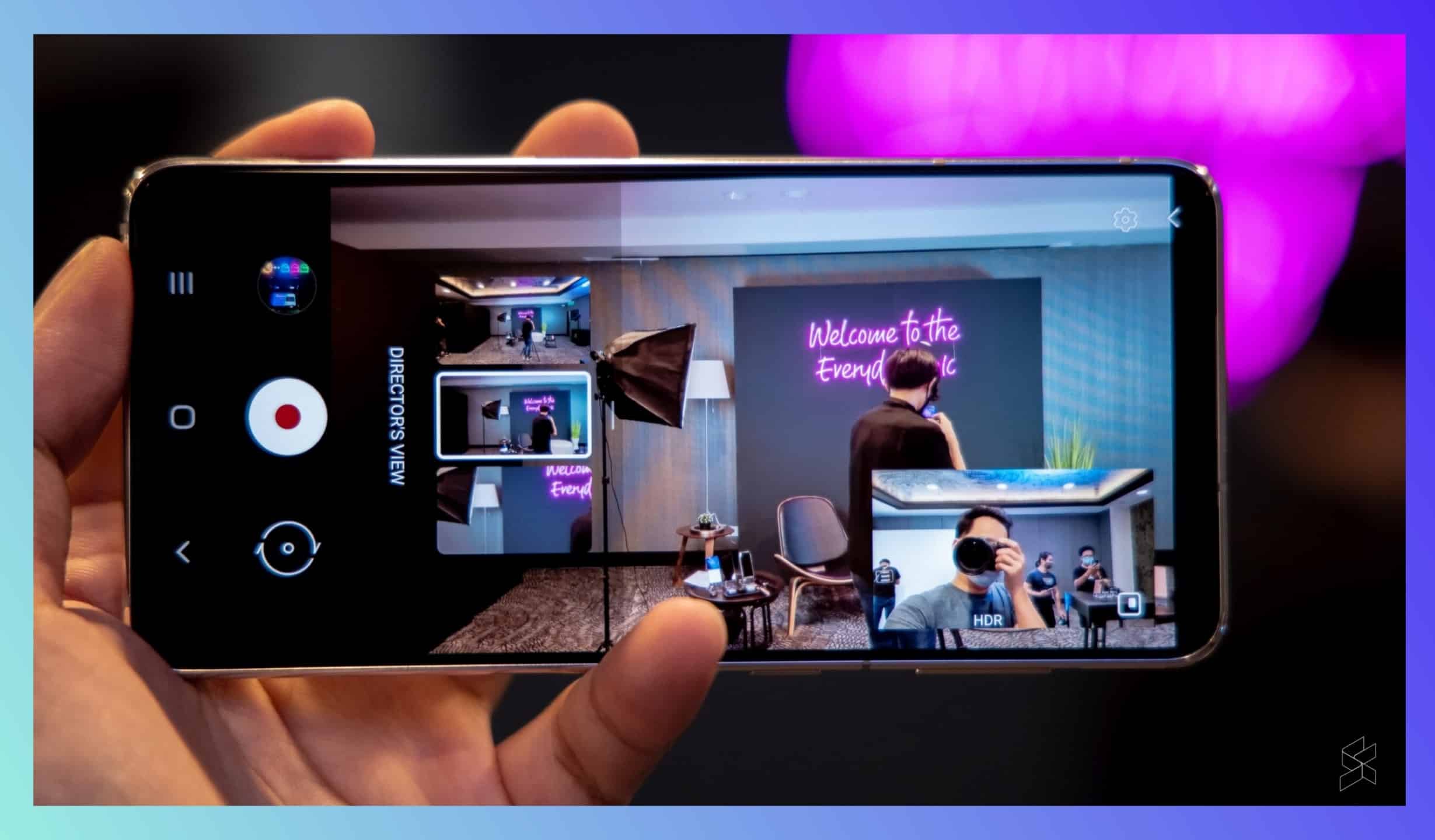
Battery and Charging
While you might consider the iPhone 13 Pro Max’s 4352mAh battery humdrum in front of Galaxy S22 Ultra’s wondrous 5000mAh cell, the results are quite literally its antipode. The stats show similar trends in the case of Galaxy S22+ and iPhone 13, where the battery capacities have a gap of over 1000mAh. iPhones largely secure a one-sided victory in this regard, almost in every price range. Do keep in mind that battery life depends on usage, so the claims might not hold true every time.
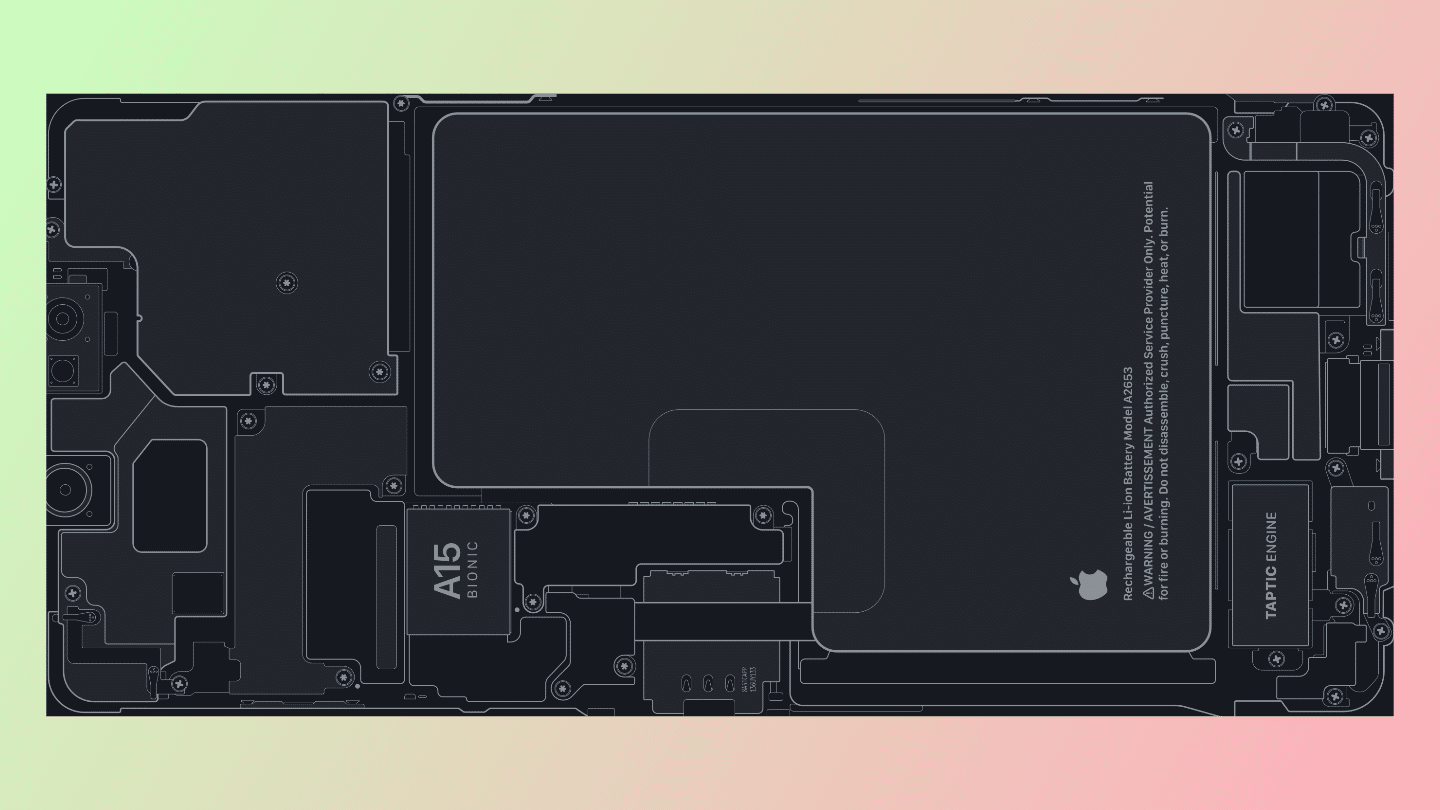
Thanks to Apple’s genius optimizations and unparalleled efficiency figures, iPhones are usually a class ahead of Samsung, whose battery optimizations are a step or two below Apple’s. All of that is achieved whilst heating lesser than Samsung, although neither of them heat alarmingly. Though, thanks to Snapdragon 8 Gen 1’s and Exynos 2200’s superior AI capabilities, Samsung phones generally adapt to the usage and train themselves to provide better screen on time. But, iPhones still last longer than their Samsung counterparts in the long run, despite adaptive battery.
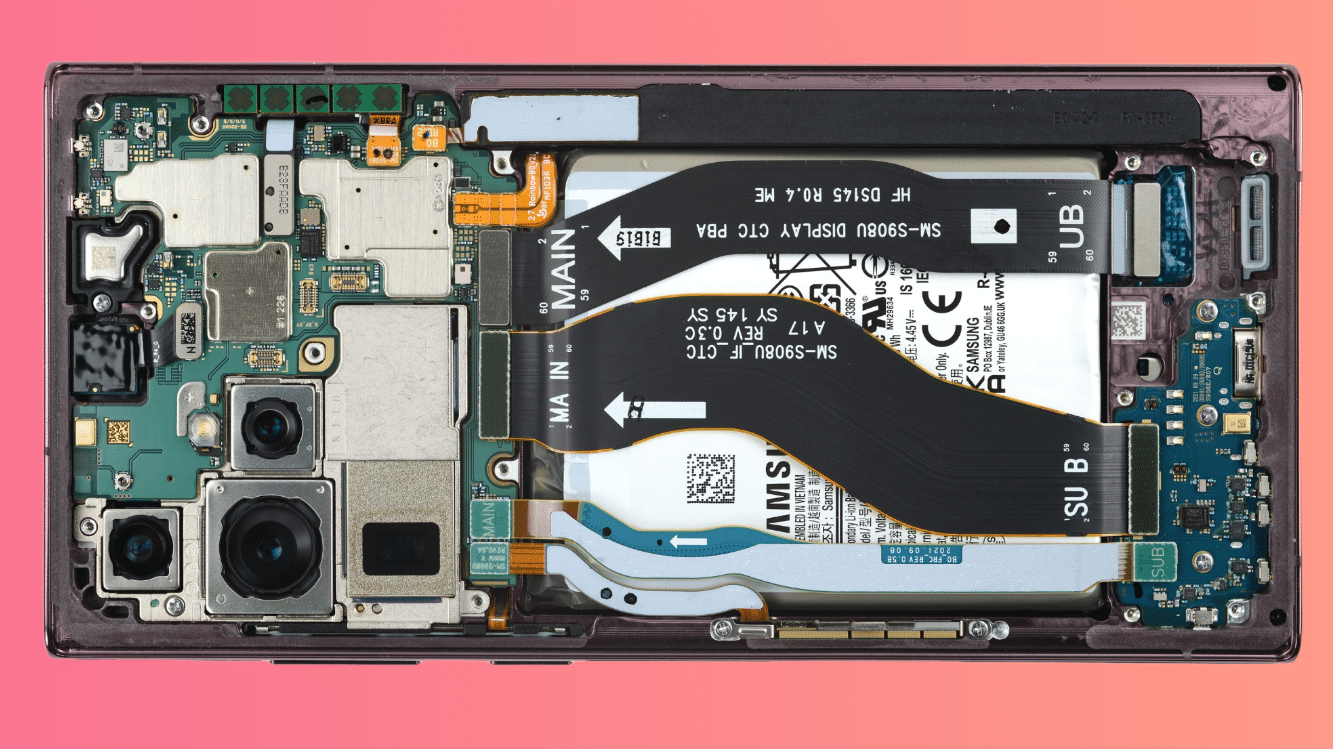
No, Apple didn’t redefine Physics in the charging department, as Samsung’s charging solution is faster theoretically and in actuality as well. Although it depends on the phone’s model and the ambience, but, in general, Samsung’s 25W and 45W charging speeds are faster than Apple’s 20W technology by around 20 minutes and 30 minutes, respectively. The iPhone does heat around the half-way mark, but cools down progressively, which is somewhat opposite to Samsung’s behavior.
Being the “Pro” phones, both the iPhone and the Samsung enjoy a few gaudy features, like MagSafe charging, reverse wireless charging, etc. While MagSafe can be used to grasp a few accessories, like a wallet, MagSafe battery pack, etc., reverse wireless charging, on the other hand, can top up your dying earbuds or smartwatch.
Now, that’s more of a personal preference, as neither of them are efficient or carry a lot of potential, as of now. The incompatibility of the lightning connector with other accessories is unfixable, so you’ll either have to adjust, or live with an assortment of adapters.
OneUI vs. iOS
If it wasn’t clear until now – Samsung phones run on a custom-skinned version of Android known as “OneUI,” whereas iPhones, of course, run on iOS. We’re pretty confident that you must’ve witnessed either of these user interfaces at some point, and you know about their design language. Looks are subjective at the end of the day, so it’s up to you.
If you talk about intuitively or one-handed usage, Samsung probably takes the cake, as most of the features are easily reachable within your fingers reach. iOS acts as an iPhone’s hallmark, and many people really do buy an iPhone just for that. Nonetheless, iOS, too, is effortless to understand and use. Altogether, iOS is a regimented piece of software, and the same results in higher stability when compared to OneUI.
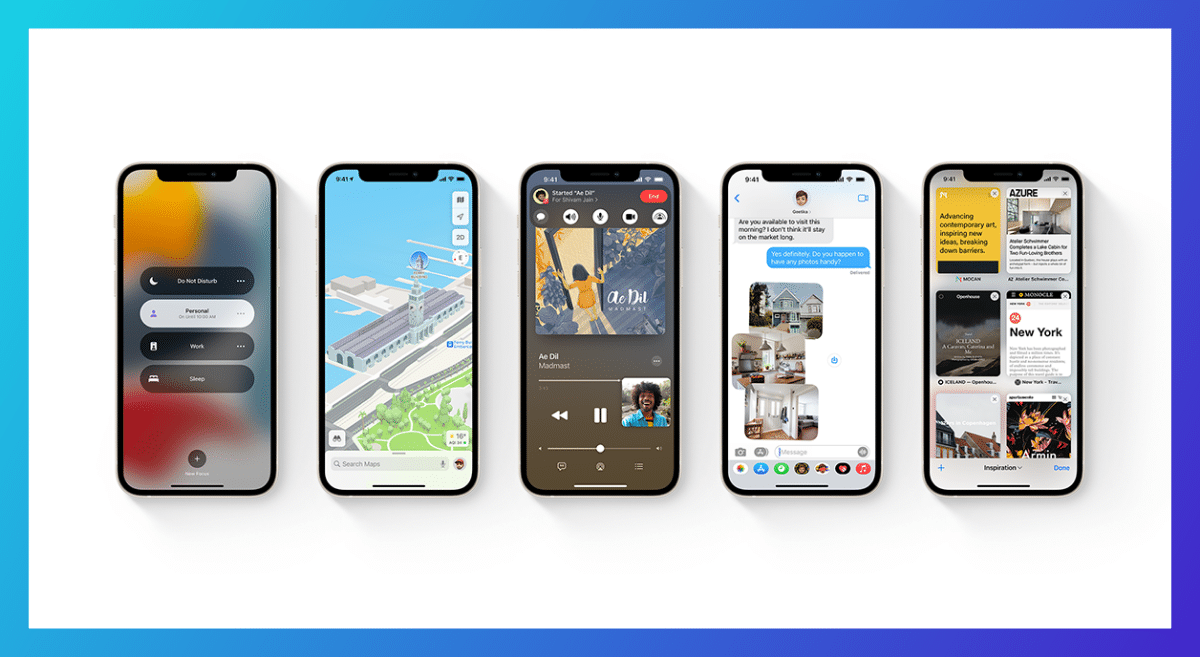
Customizability and the open nature is quite possibly the biggest reason people love Android over iOS. Almost every desired feature can be implemented by some or the other way, including replicas of certain features of iOS as well. Obviously, it will not be as flawless, but it surely gets the job done.
Words cannot express the extent of customizability Android offers, be it altering the whole UI using a launcher, trying out different icon packs or live wallpapers, rooting your phone, and whatnot. It’s easier to make your Galaxy “yours.” Android’s way of notification and file management is just streets ahead of iOS. The recently announced lock screen personalization in iOS 16 is a treat for the eyes.
iOS is the king of the hill when it comes to fluidity and animations, and Samsung doesn’t come close at all. OneUI needs a lot of polishing in that regard. Privacy is a myth, but, the way Apple has positioned itself definitely influences one’s thinking, and for the most part, it’s accurate. A small example of is how Apple has implemented Face ID to transact every minor thing, including installation of an app.
Galaxy devices aren’t perilous either, thanks to Knox Security; it’s just that Apple’s identity injects a tiny dose of immunity. Truth be told – unlocking your iPhone using Face ID can be challenging at times, mainly because it requires high precision of your visuals, which can be hampered by lighting conditions, angle of your head, and foreign objects like masks and sunglasses, etc. Ultrasonic fingerprint scanners present on Samsung phones are much more versatile.
After the recent promise of Samsung on providing 5 years of software support, both iPhone and Samsung are nip and tuck in that respect. While Apple provides an extra year of update to many of its popular models, the point worth mentioning is that sometimes, the newer features aren’t compatible with older models, which isn’t the case with Samsung.
Neither Siri nor Bixby are incapable of answering your daily queries or trivia questions, but the latter needs to speed up a tiny bit. Siri occasionally fails to perform tasks that are to be done in third-party apps, but that’s forgivable. Both excel in commands related to first-party apps, and offer a fantastic portfolio of automation features in the form of “Shortcuts” and “Bixby Routines.”
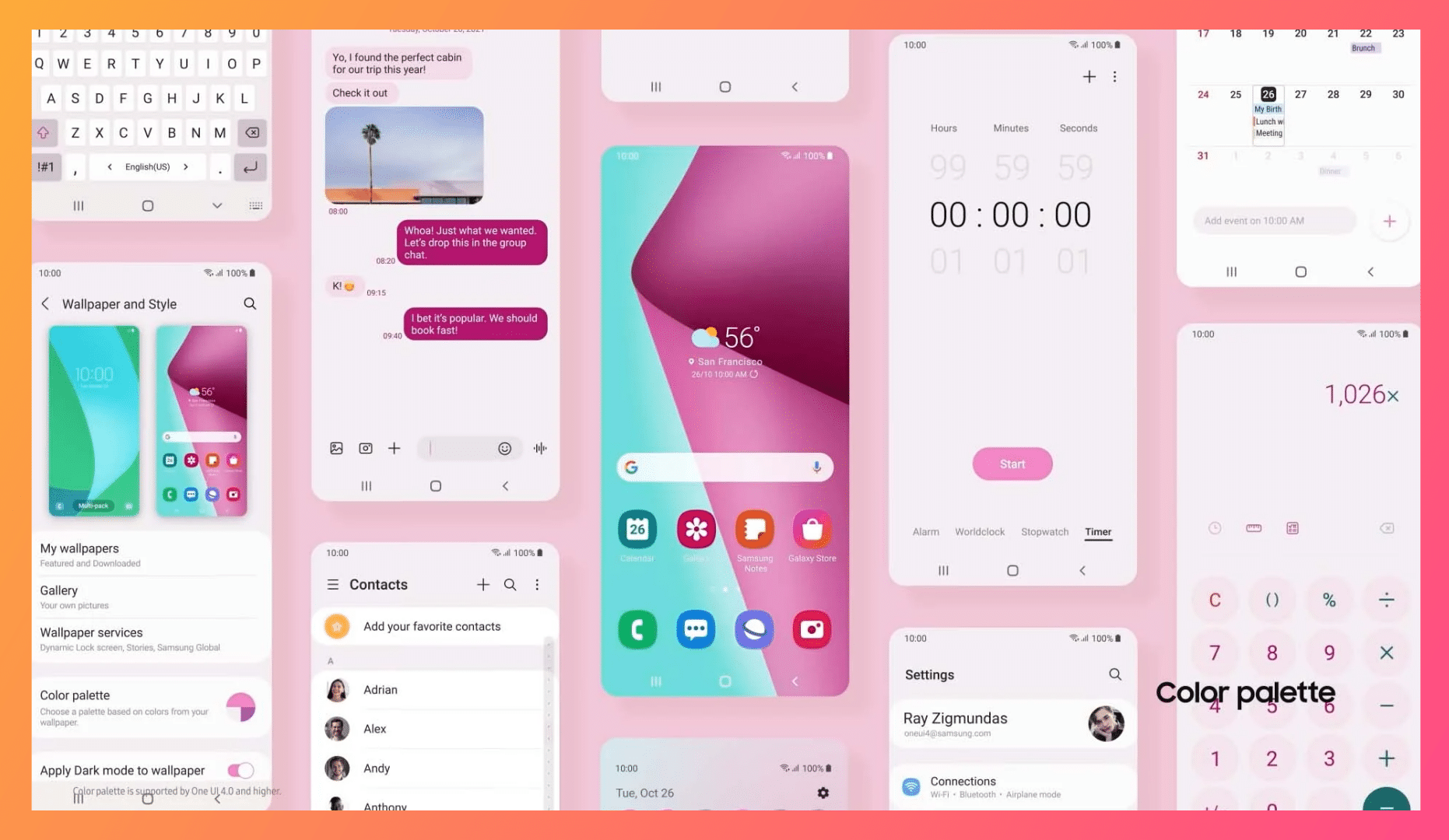
iOS has an ace up its sleeve in the form of certain “exclusive” apps. Yes, these include iMessage, Safari, Apple Maps, etc., that are unreplicable on Samsung or any other Android phone. You’ll have to compute their importance in your lifestyle, as many users opt for alternatives like WhatsApp, Chrome, Google Maps, etc. Samsung, too, has certain exclusive apps like QuickShare, Samsung Flow, and so on.
While the Galaxy Store is utter garbage, you really cannot undermine the sheer vastness of Google Play Store in front of the App Store. Not to mention, many apps are cheaper on Play Store. Since Apple releases only a handful of models each year, it becomes easier for developers to optimize their apps for Apple devices, and the prime examples of that are superior quality Instagram stories and WhatsApp voice notes.
The “Ecosystem”
Both Apple and Samsung are probably the only two brands to have a genuine ecosystem of products and AIoT gadgets. It gets reflected in their product lineup, as they have a similar set of products – tablets (iPad and Galaxy Tab), laptops (MacBook and Galaxy Book), audio gear (AirPods and Galaxy Buds), smartwatches (Apple Watch and Galaxy Watch), etc.
Apple also sells personal computing machines, like the iMac, Mac Mini, Mac Studio, Mac Pro, and other gadgets like Apple TV, HomePod, etc. Samsung, on the other hand, sells a plethora of household appliances alongside. While we won’t be comparing the products individually, we will surely speak about how interconnected the products are.
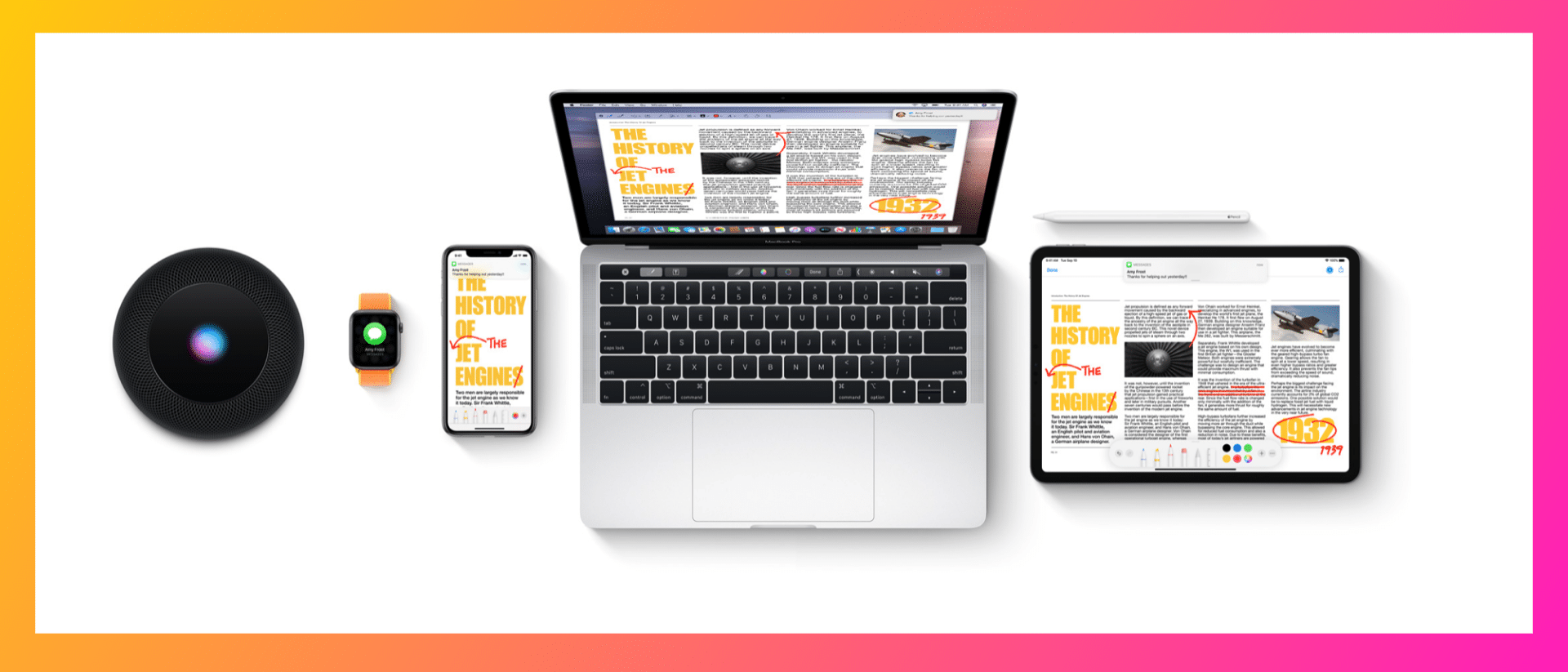
The sayings aren’t wrong – Apple products work together splendidly. Some features include taking calls on your PC, sending files between devices (AirDrop), using your tablet to control your PC and vice versa (Universal Control), copy and paste between devices seamlessly (Universal Clipboard), continue your work on other devices from the point you left off (Hand Off), use your iPhone as a webcam for your Mac natively (Continuity Camera), connect to your iPhone’s hotspot quickly, and much more.
The setup is a breeze to perform, and no feature is half-baked. You also cannot forget the instant switching of AirPods between devices, tap to play on HomePod, AirPlay, and the interconnected ‘Find My’ network. That said, Apple isn’t particularly friendly towards third-party ecosystem add-ons. For example, you can’t take full advantage of third-party smartwatches, transfer files directly between an iPhone and a Windows PC, etc.
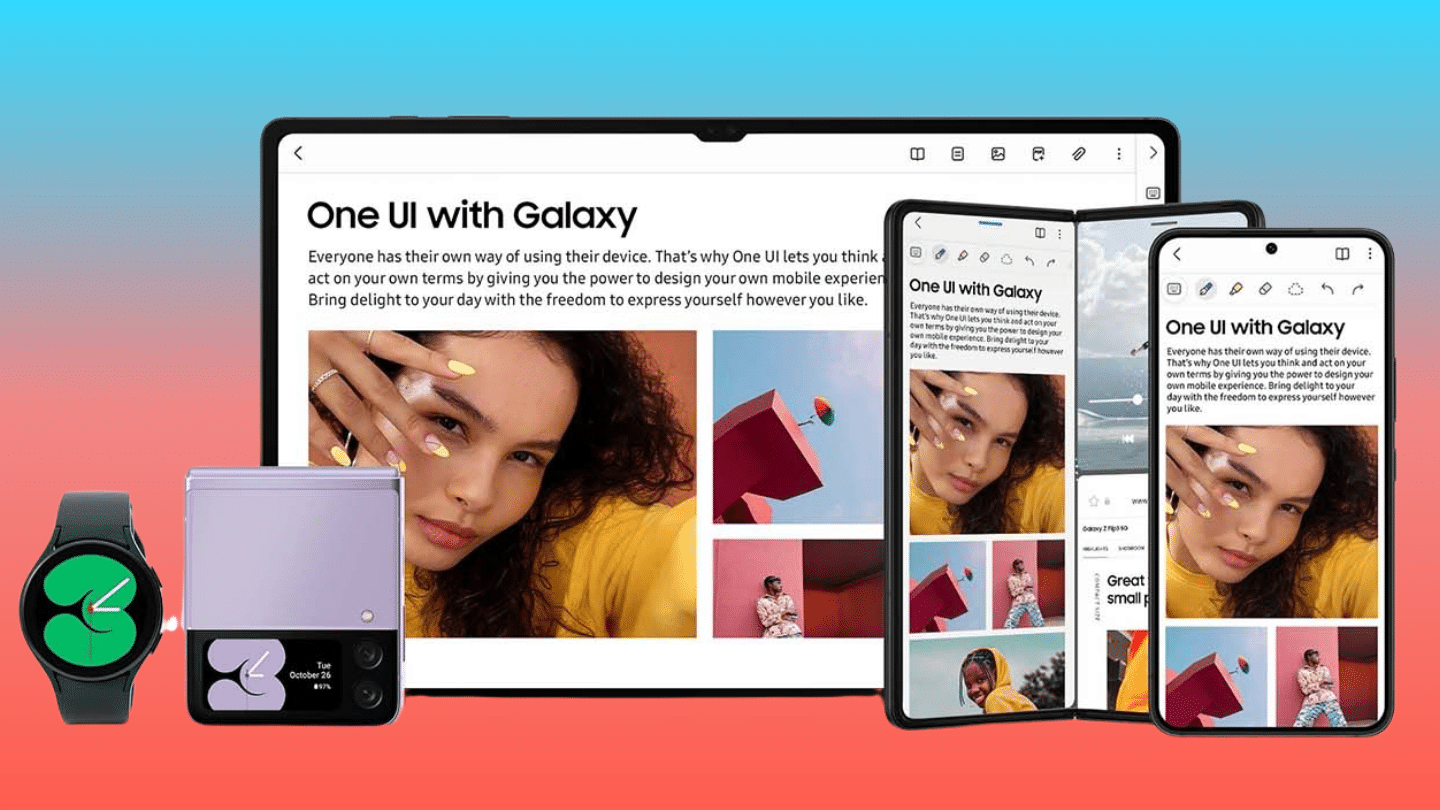
While Samsung also has all the aforementioned features in some or the other form, it all comes down to a question of reliability and consistency. Since Samsung has to deal with two other platforms for perfecting a feature (i.e., Windows and Android), the features feel unpolished occasionally.
Nonetheless, Samsung’s underrated ecosystem offers additional attributes like the ability to run android apps on Windows (via Microsoft Phone Link app), mirror your phone’s notification and interact with them (via Samsung Flow), etc. The best part is that you don’t necessarily need a Galaxy Book for enjoying most of the Windows-related features. Overall, either of the companies have a laudable ecosystem, but Apple’s is a touch more refined.
Repairs and After-Sales Service
Because this attribute revolves around the service center, and the region to some extent, we’d keep it short and crisp. No one loves going to the service center, but if you had to, you’re more likely to spend more in case of Apple. No doubt, iPhone’s replacement parts cost a nightmare, and it’s no fun paying such high amounts. For instance, in India at least, the back glass panel of an iPhone 13 Pro costs ten times more than that of a Galaxy S22 Ultra. The screen, too, is nearly 50% expensive.
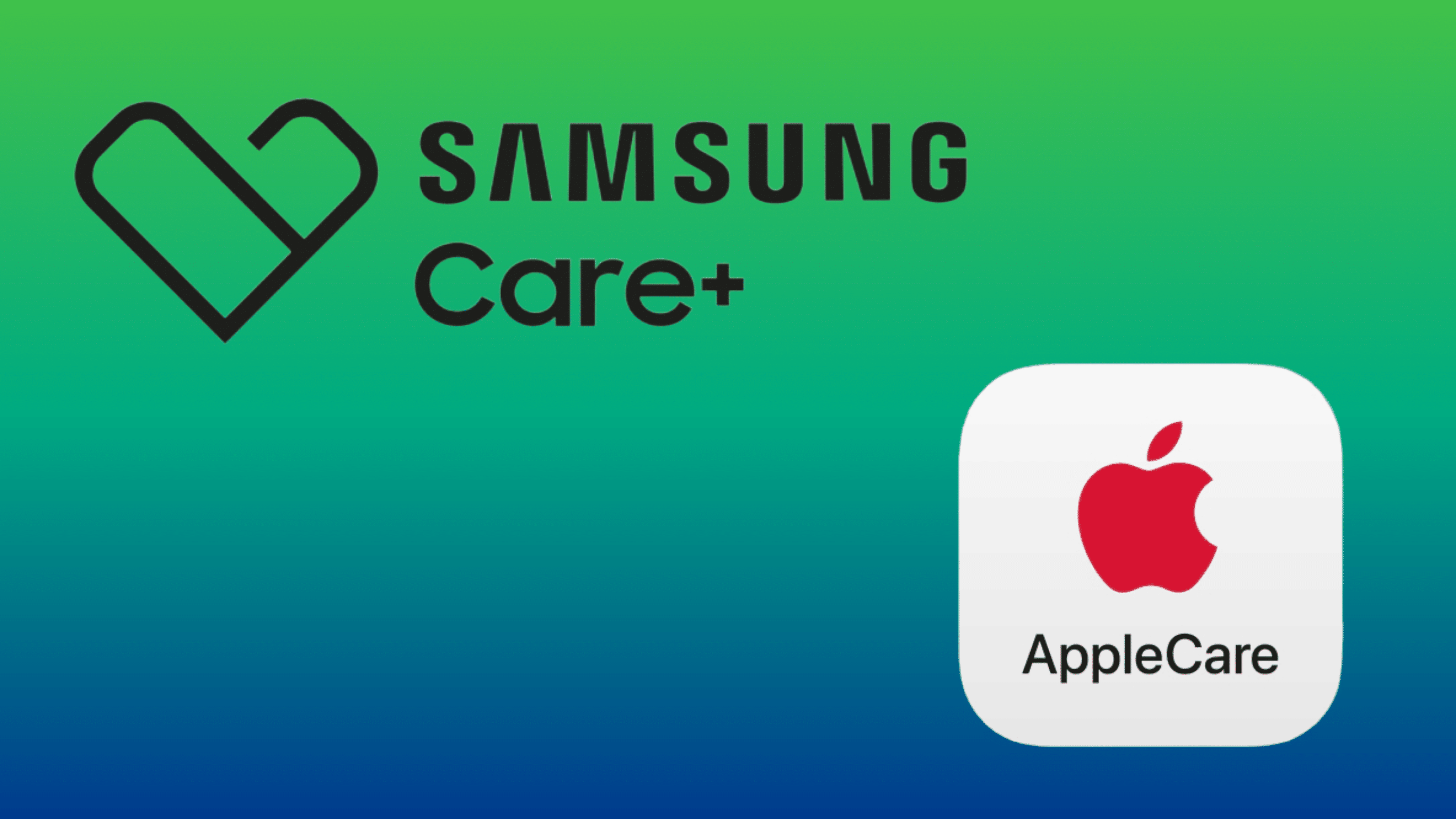
Credits where it’s due – Apple’s repair process is very refined and streamlined. People have also reported of getting their devices replaced for free, even for the tiniest of issues. Samsung’s repair procedure is superb too, but Apple’s is a class above. Availability of parts is region-specific, but, Samsung has the upper hand in India as of now.
Pricing and Resale
iPhones are already infamous for being stupidly expensive, but, what’s engrossing is that Galaxy phones come no cheap either. As of now, the iPhone 13 Pro Max starts at $1,099.00, while the Galaxy S22 Ultra starts at $1,199.00. Sure, Samsung usually runs offers that are unheard of, like getting free a free power adapter, a pair of Galaxy Buds, or even a Galaxy Watch!
Moreover, there are extraordinary trade-in benefits, free upgrades to higher storage models, benefits for students, military personnel, and whatnot. Regrettably, most or almost all of the above benefits aren’t available outside the US.
However, in India and many other regions, the iPhone is considerably costlier than Samsung. People buying the iPhone are well aware of the pricing, but they still buy it because they’re sure to recover its value by using it for a long time.
Samsung’s phones are definitely cheaper in the initial phase (if you count in the offers), but they definitely haven’t created an identity of lasting longer and proving their worth eventually. Besides that, certain non-tangible things like brand identity, the Apple logo, etc., persuade people to spend a little extra. This gets reflected in the sales figures too.
Summarizing it, Galaxy phones seem more value for money initially, but, it’s the iPhone that makes the owner realize its worth. iPhones generally have a far better resale value, however, trading in for a Samsung phone would certainly fetch an equally impressive, or sometimes better value for your Galaxy device than an iPhone. And, not everyone sells their old device, so that’s that. Accessories for an iPhone, though expensive, are conveniently available. The same isn’t the case with Samsung.
iPhone or Samsung: What To Choose?
The long battle ends here. There’s no particular winner of this battle, as both brands won in some or the other aspects, whose importance are based on the user. Here’s a thumb rule: if you’re someone who likes their phone to be different, quirky, and adventurous, or want an Android phone anyway – you should go for a Galaxy. The customizations, minute settings, and the open nature of Android is definitely a boon. But, it does result in some amount of inconsistency and imperfection.
Inversely, if you’re already locked in the Apple ecosystem, or want an iPhone doubtlessly – get an iPhone. You’ll get to enjoy perfection, an impeccable ecosystem of devices, and perfectly thought out features. Yes, it might get boring after sometime, as iPhones don’t usually get to enjoy the latest hardware innovations or first-in-segment software features. That, however, is perfect for reliability and long-term stability. The end decision is solely yours.
Thank you so much for reading our article until the end. Please fell free to give your suggestions/feedback in the comments section.